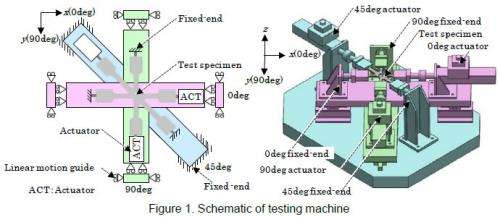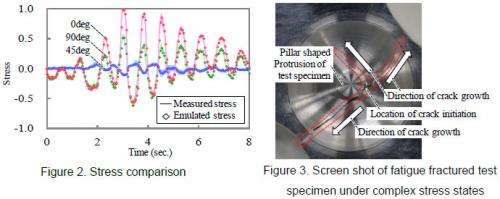New computer-controlled tri-axial fatigue testing machine for precise emulation of mechanical fatigue

Hitachi, Ltd. announced the development of a new computer-controlled tri-axial material fatigue testing machine to emulate the complex stress conditions subjected during operation on mechanical structures such those in construction machinery and renewable energy facilities. When the testing machine was used to emulate the stress conditions on actual construction machinery using a test specimen, it was found that stress conditions could be emulated within an error range of less than 3%. By applying this fatigue testing machine to optimizing the design of social infrastructure products, Hitachi will be able to achieve the most appropriate structural design in line with the use conditions thus contributing to improved reliability as well as reducing material costs.
Reliable operation over a long time span is extremely important in mechanical structures supporting social infrastructure such as railways, construction machinery and wind turbines. Stress is generated on the surface of mechanical structures through structural deformations in the transverse, longitudinal and diagonal directions. Previous studies have reported that fatigue fractures of mechanical structures tend to be accelerated if working stressors become multi-directional. If the fatigue phenomenon under complex stress conditions could be elucidated and emulated with high accuracy, then it would be possible to preempt fatigue damage by designing a more durable structure, thus reducing resources and costs.
In conventional material tests, it was possible to elucidated the fatigue phenomena in relation to unidirectional load but technical difficulties in applying a multi-directional stress load on a test specimen prevented the emulation of arbitrary stress on test specimens. To overcome this, Hitachi has developed a new tri-axial material fatigue testing machine which is able to apply complex stress conditions on a test specimen, emulating real-world operating conditions. Key features of the testing machine are summarized below.
(1)Emulation of stress conditions
Surface stress on mechanical structures can be described as in-plane structural element deformations in transverse, longitudinal and diagonal directions. However, as conventional material fatigue testing machines are only able to apply two of the aforementioned deformations to a test specimen, accurate reproduction of complex stress conditions was difficult. The new tri-axial material fatigue testing machine is able to emulate stress states working on surfaces of mechanical structures by applying three independent loads to the test specimen using actuators which apply loads in the 0, 45 and 95 degree direction.

(2)Tri-axial material fatigue testing machine
The testing machine developed consists of a fixed frame which forms 45-degree axis and two movable frames which form 0-degree and 90-degree axes. A load is applied in each direction by a corresponding actuator controlled by a computer. As the test specimen is fixed, when a load is applied, the center of the test specimen may move causing unexpected fatigue fractures in non-evaluation areas of the test specimen. In order to avoid this technical issue, linear motion guides were implemented in the machine frames to cancel-out the movement of the center position of test specimen (Fig 1).
Evaluations were conducted on a test specimen with complex stress data obtained from actual operating construction machinery, it was found that the measured stress and the emulated stress corresponded with an error range of less than 3% (Fig 2 and Fig 3).
When additional fatigue tests were performed on a test specimen with a small pillar shaped protrusion to illustrate the difference between uni, bi, and tri-axial loading conditions, fatigue strength clearly fell as the number of load dimensions increased.
Hitachi will continue to develop quantitative measurement technology for fatigue phenomena in complex stress conditions and promote technology development for even more reliable products for social infrastructure. The technical details of the this tri-axial fatigue testing machine will be presented at the 63rd technical meeting of the Society of Material Sciences, Japan, to be held on 17th- 18th May 2014 at Fukuoka University, Fukuoka, Japan.
Provided by Hitachi


















